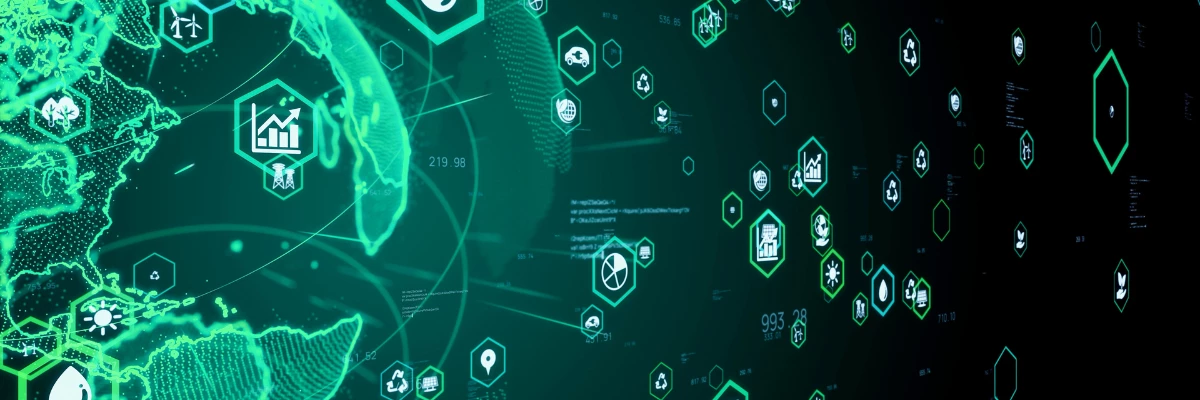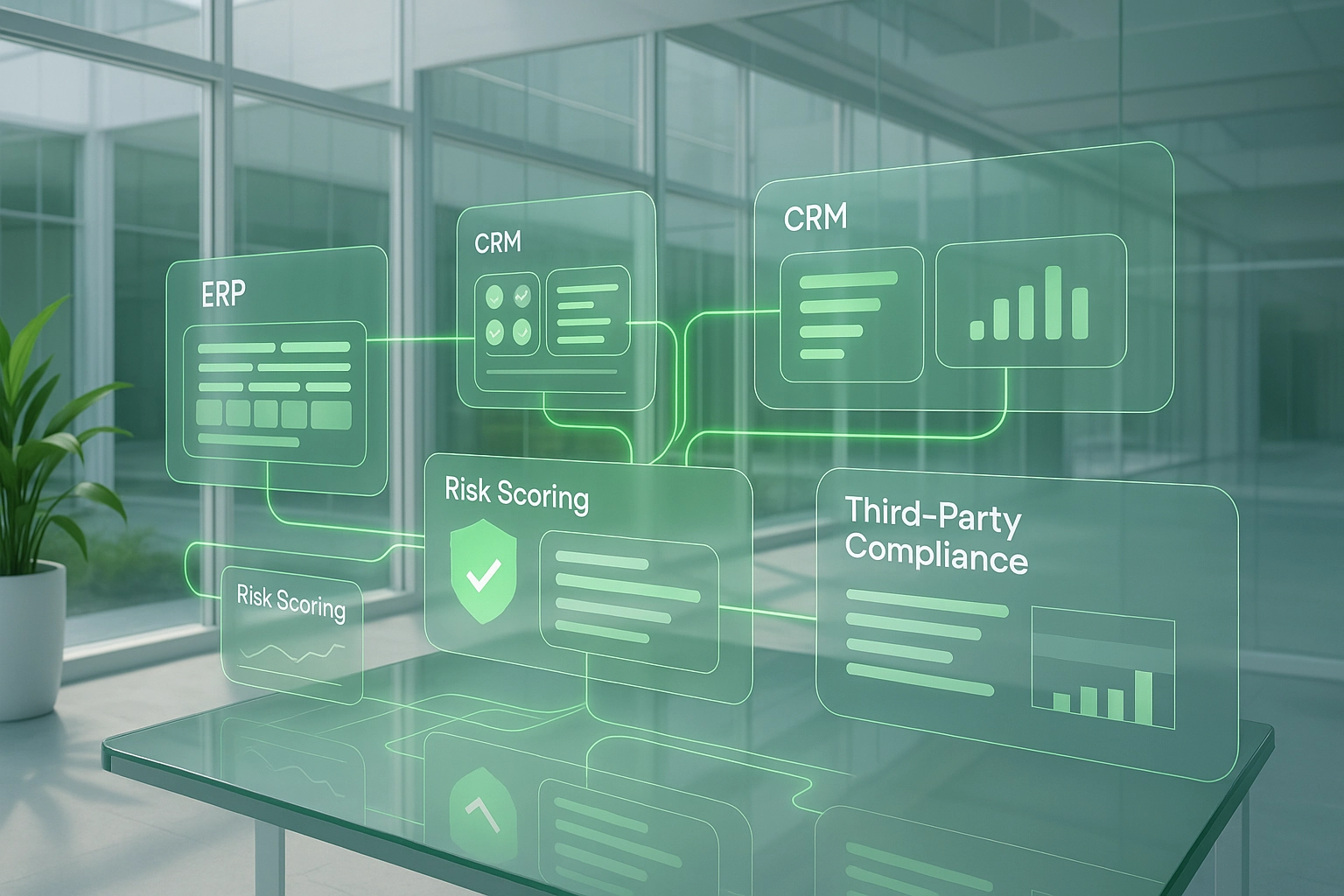Digital Transformation and Third-Party Governance: A New Era for Risk Management

Digital transformation is profoundly redefining the way organizations manage their relationships with third-party partners. In this rapidly evolving context, third-party governance is taking on a crucial strategic role, moving from simple document collection to collaborative compliance assessment. This shift is part of a broader movement toward Third Party Governance and Risk & Compliance (TPGRC), which succeeds the traditional Third Party Risk Management (TPRM).
We are entering a truly new era, characterized by the convergence of three disruptive forces: the integration of artificial intelligence into third-party evaluation processes, the harmonization of international regulatory frameworks, and the transition from a reactive control approach to a collaborative, shared governance model that fundamentally redefines relationships with external partners.
The stakes are high: according to a recent study, 61% of companies experienced a cybersecurity incident linked to a third party in 2023, an alarming 13% increase compared to the previous year. This reality underscores the urgency of adopting innovative approaches to assess and manage external partner compliance.
In this article, we will explore how digital transformation impacts third-party governance and why this evolution is essential for optimizing operational resilience. We will also address the role of advanced technologies in building sustainable digital trust within the third-party ecosystem.
The Impact of Digital Transformation on Governance
Digital transformation is fundamentally redefining third-party governance approaches in the public sector. According to a study, France has made significant progress in digitizing public services, but there is still room for improvement.
Digitizing Governance Processes
Digitization is transforming traditional governance processes by replacing paper-based documentary systems with integrated assessment platforms. In the French public sector, this transformation aims to improve administrative efficiency and deliver a better experience for citizens.
The Tech.gouv 2019–2022 program, led by the Interministerial Directorate for Digital Affairs, focuses on six key priorities, including improving service quality for users and modernizing the work environment for public agents.
Optimizing Governance with Digital Solutions
The adoption of tailored technological solutions is a key lever for optimizing third-party governance in the public sector. According to an EY study, the most advanced areas of digital transformation in public administration are those with the highest user interaction, such as public enterprises (50%) and social protection services (41%).
In healthcare and vocational training, digitalization requires a less hierarchical, more transversal way of working, fostering collaborative methods.
This digital shift paves the way for developing innovative, personalized services better suited to the specific needs of citizens, while strengthening transparency and accountability in administrative actions.
Case Studies and Success Stories
Case studies show how digital transformation is revolutionizing third-party assessment in practice. According to a Deloitte study, 87% of organizations have experienced a disruptive third-party incident in the past 2–3 years, with 28% facing major disruptions. These figures highlight the critical importance of effective digital governance in managing third-party relationships.
Case Study: Industrial Sector
In the industrial sector, Shell perfectly illustrates the impact of digital transformation on third-party governance. The company has deployed integrated data platforms enabling collaborative assessment of partners across its value chain. Through advanced collaborative environments, geographically dispersed teams can work together in real time on projects using digital twins and other data visualization tools.
This approach enables continuous monitoring and proactive maintenance, ensuring both worker safety and production process optimization. Operational resilience has significantly improved thanks to data-driven decision-making instead of relying on intuition.
Success Story: Construction Sector
In the construction sector, Skanska transformed its third-party governance during the Karlatornet project in Sweden. The company used Building Information Modeling (BIM) to create a shared digital model with all external partners, including architects, engineers, and subcontractors.
This integrated assessment platform allowed Skanska to refine the construction process, reduce errors, and improve efficiency. The project also leveraged 3D scanning technology to manage development and instantly identify potential complications, enabling faster, more accurate decision-making. Key success factors included strong leadership, innovation adoption, technology investment, and a collaborative approach with third parties.
Want to learn how to optimize your third-party governance in your sector?
Explore our customer success stories and discover how companies like yours have transformed their approach to partner evaluation.
Third-Party Risk Management in the Digital Age
Digital transformation is redefining how organizations manage risks linked to their third-party partners. A proactive and collaborative approach is essential to ensure operational resilience in a constantly evolving environment.
Proactive Risk Identification
Proactive risk identification is essential to anticipate potential threats before they materialize. According to a global EY study on third-party risk management (2023), 90% of organizations have directly invested in their TPRM programs to improve reporting, deepen risk understanding, and align skills. This approach shifts organizations from reactive management to a preventive strategy based on in-depth data analysis.
In the public sector, for example, continuous subcontractor monitoring can prevent delays in critical infrastructure projects by consistently assessing regulatory compliance. This heightened vigilance enhances the ability to anticipate and mitigate potential risks.
Real-Time Assessment and Monitoring
Collaborative assessment and real-time monitoring of third parties have become indispensable for maintaining an up-to-date risk picture. Modern digital platforms enable continuous monitoring with instant alerts on changes in third-party risk profiles. The same EY study shows that 63% of organizations plan to integrate external data providers and automation to better manage inherent risk assessment over the next 2–3 years.
In industry, these monitoring tools can anticipate supply chain disruptions by analyzing factors such as REACH compliance or evolving ICPE standards. This foresight turns third-party governance from a simple control function into a strategic advantage for operational resilience.
Implementing a continuous monitoring system not only quickly detects anomalies but also adjusts risk management strategies in real time. This dynamic approach is particularly crucial today, with threats evolving rapidly and regulatory compliance becoming increasingly complex.
Digital Strategy to Strengthen Governance
Digital transformation is redefining how organizations manage their third-party partners. A coherent digital strategy is essential to optimize third-party governance and ensure operational resilience.
Strategic Technology Deployment
Adopting advanced technologies is crucial for effective collaborative assessment of third parties. According to a McKinsey study, organizations using AI-driven analytics in governance see a 25% reduction in compliance costs. These tools enable continuous monitoring and real-time, data-driven decision-making.
Aprovall’s collaborative approach directly addresses the growing challenge of supplier fatigue — the weariness third parties feel from repeated, redundant evaluation requests. In fact, suppliers can receive dozens of similar questionnaires each month from different clients. The pay-to-collect model, with shared data, significantly reduces this administrative burden by centralizing already-collected information and avoiding repetitive requests. This turns third-party evaluation from a perceived constraint into a collaborative process that builds trust and improves shared data quality.
In the distribution sector, for example, using integrated assessment platforms can help anticipate risks related to international marketplaces, offering greater visibility into partner compliance and enabling early anomaly detection.
Building Credibility Through Transparency
Transparency is essential for establishing trust in the digital transformation process. Companies that adopt clear communication channels have seen a 35% decrease in attrition rates. This approach strengthens operational resilience by engaging all stakeholders.
In the public sector, implementing automated reporting systems for public procurement enhances transparency and facilitates GDPR compliance. This boosts trust among citizens and institutional partners.
A robust digital strategy, combined with a transparent approach, enables organizations to transform their third-party governance from a simple control function into a genuine strategic advantage while meeting increasing regulatory demands such as DORA, NIS 2, and CSRD.
Future Challenges in Third-Party Governance
Third-party governance is evolving rapidly under the influence of new technologies and regulatory requirements. This marks a fundamental transition from simple Third Party Risk Management (TPRM) to a more integrated approach of Third Party Governance and Risk & Compliance (TPGRC), redefining how organizations assess and manage external partners.
Adapting to Changing Regulations
The regulatory environment is expanding significantly, particularly in Europe, with new directives emerging. According to a recent OCEG study published in 2025, organizations face unprecedented regulatory complexity, with accelerated convergence of requirements for operational resilience, cybersecurity, and ESG reporting. This reality is driving regulators to strengthen the frameworks governing external partner management.
Regulations such as DORA, NIS 2, and CSRD are profoundly reshaping the third-party governance landscape by imposing stricter obligations in cybersecurity, ESG reporting, and digital resilience. In the distribution sector, these new demands require increased vigilance over international marketplaces and complex supply chains.
Resilient Partnerships
Modern third-party governance is shifting from a control-based relationship to a collaborative partnership model. As Luke Ellery, analyst at Gartner notes, “critical third parties should be treated as allies, moving from a monitoring strategy to a partnership strategy.” This approach fosters transparency and improves collaboration in the event of incidents.
In the construction sector, managing multi-tier subcontractors now requires collaborative evaluation rather than a simple audit. This transition to resilient partnerships not only meets regulatory requirements but also anticipates supply chain risks, particularly for critical infrastructure projects.
Implementing effective third-party governance therefore requires a proactive, collaborative, and technologically advanced approach — one capable of adapting to regulatory changes while strengthening the operational resilience of the entire ecosystem.
Ready to unlock the full potential of every third-party relationship?
Discover how Aprovall can help you simplify and secure your partner evaluations with our Aprovall360 platform. Request a personalized demo and transform your third-party governance approach today.
These articles might interest you
-
 14 September 2024Aprovall supports you in your new due diligence obligations arising from the European CS3D Directive.SolutionsThe Corporate Sustainability Due Diligence Directive, known as “CS3D”, was definitively adopted on Wednesday, April 24, 2024, by the European Parliament. The directive now needs to be officially approved by the Council and signed before being published in the EU Official Journal. It will enter into force 20 days later. Member States will then have […]
14 September 2024Aprovall supports you in your new due diligence obligations arising from the European CS3D Directive.SolutionsThe Corporate Sustainability Due Diligence Directive, known as “CS3D”, was definitively adopted on Wednesday, April 24, 2024, by the European Parliament. The directive now needs to be officially approved by the Council and signed before being published in the EU Official Journal. It will enter into force 20 days later. Member States will then have […]Read more
-
 02 April 2025Understanding Scope 3 Assessment in the Value ChainSolutionsAnticipating Your Carbon Footprint by Assessing Suppliers and Identifying Scope 3 Maturity In a context where third-party environmental governance is becoming a major strategic issue, companies must now evaluate and manage the carbon impact of their entire value chain. Scope 3 assessment represents a considerable but essential challenge to ensure organizations’ operational resilience in the […]
02 April 2025Understanding Scope 3 Assessment in the Value ChainSolutionsAnticipating Your Carbon Footprint by Assessing Suppliers and Identifying Scope 3 Maturity In a context where third-party environmental governance is becoming a major strategic issue, companies must now evaluate and manage the carbon impact of their entire value chain. Scope 3 assessment represents a considerable but essential challenge to ensure organizations’ operational resilience in the […]Read more
-
 30 January 2025Integrating Information Systems into TPRM PlatformsSolutionsIntegrating information systems into TPRM platforms has become a major strategic issue for organizations. A recent study reveals that 41% of companies experienced a serious third-party breach in the past 12 months, underlining the urgency to adopt robust third-party governance solutions. In this context, Third-Party Risk Management (TPRM)platforms are evolving to offer a more collaborative and […]
30 January 2025Integrating Information Systems into TPRM PlatformsSolutionsIntegrating information systems into TPRM platforms has become a major strategic issue for organizations. A recent study reveals that 41% of companies experienced a serious third-party breach in the past 12 months, underlining the urgency to adopt robust third-party governance solutions. In this context, Third-Party Risk Management (TPRM)platforms are evolving to offer a more collaborative and […]Read more
-
 11 March 2025Comprehensive Methodology for Third-Party Risk MappingSolutionsIn today’s business environment, where relationships with external partners are strategic, third-party governance has become an essential priority. Third-party risk mapping is a critical tool for identifying, structuring, and prioritizingfactors that may impact the organization. According to a recent Gartner study, over 60% of organizations have now implemented a centralized or federated model for managing third-party risks, […]
11 March 2025Comprehensive Methodology for Third-Party Risk MappingSolutionsIn today’s business environment, where relationships with external partners are strategic, third-party governance has become an essential priority. Third-party risk mapping is a critical tool for identifying, structuring, and prioritizingfactors that may impact the organization. According to a recent Gartner study, over 60% of organizations have now implemented a centralized or federated model for managing third-party risks, […]Read more
